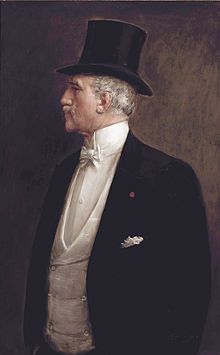Jean Béraud

Jean Béraud (born December 31, 1848 July / January 12, 1849 greg. In Saint Petersburg , Russian Empire , † October 4, 1935 in Paris ) was a French painter and graphic artist .
Life
Jean Béraud was born in Saint Petersburg, the son of the sculptor Jean Béraud and his wife Geneviève Eugénie Jacquin. The family continued to include his twin sister Mélanie and the sisters Adrienne and Estelle. The Jean Bérauds family lived in Saint Petersburg at the time of his birth because his father, a sculptor, worked here. Presumably he was involved in the completion of the new St. Isaac's Cathedral . After the father's death in 1853, the family returned to Paris. Here he first attended the Lycée Bonaparte (today Lycée Condorcet ) and then took up law studies to become a lawyer. After the Franco-Prussian War , however, he decided to train as an artist. Béraud attended the École des Beaux-Arts for two years and became a student of Léon Bonnat . Then Béraud moved into his own studio in the artists' quarter of Montmartre .
From 1873 to 1889 he exhibited regularly at the Paris Salon . He received his first recognition here in 1876 for the painting Le Retour de l'enterrement ( The way home from the funeral ). Since 1885, Béraud was a member of the Société des Pastellistes , which exhibited the works of its members in its own pavilion at the 1889 World's Fair . Béraud received a gold medal here. From 1890 to 1929 he exhibited his pictures in the Salon de la Société Nationale , which he founded together with Auguste Rodin , Jean-Louis-Ernest Meissonier and Puvis de Chavannes .
In 1894, Jean Béraud was appointed officer of the Legion of Honor . In February 1897 he served his friend Marcel Proust as a second when he dueled with the critic Jean Lorrain . Towards the end of the 19th century he devoted himself less to his own painting, but worked in the organization of the Société Nationale des Beaux-Arts, in numerous exhibition committees and juries. Jean Béraud never married and had no children. His grave is next to that of his mother and twin sister on the Cimetière Montparnasse .
plant
Following his teacher Bonnat, Béraud began his career as a portrait painter. In 1875 he turned to a mythological topic for the first time with Leda . The Retour de l'enterrement , exhibited in the Salon in 1876, was the breakthrough for the artist. In it he showed a funeral party after the funeral in a relaxed atmosphere. While one man is lighting a cigar, other people are deep in conversation. This street scene was the prelude to numerous similar motifs. His depictions of the Champs-Elysées , the halls , Montmartre and the banks of the Seine are detailed images of everyday life in Paris during the Belle Époque . An example of this is the painting La Pâtisserie Gloppe from 1889. The style of his painting ranges between academic painting and impressionism . While most of the Impressionists escaped from turbulent Paris and painted the surrounding landscape, Béraud found models in his friend Édouard Manet and Edgar Degas , whose motifs also included the depiction of lively city life.
From 1890, Béraud also turned to religious subjects in his pictures. These paintings are reminiscent of 17th century Dutch painting. In the Salon in 1891 he exhibited a biblical scene with La Madeleine chez le Pharisien in which the persons depicted wear contemporary clothing. This realistic implementation of a traditional pictorial theme was considered scandalous by the art critics of the time.
Works
La Madeleine chez le Pharisien .
Jesus, Maria Magdalena and Ernest Renan (in the middle), authors of The Life of Jesus .
literature
- V. Ritter: Béraud, Jean . In: General Artist Lexicon . The visual artists of all times and peoples (AKL). Volume 9, Saur, Munich a. a. 1994, ISBN 3-598-22749-3 , pp. 227 f.
- Ursula Bode : Paris - Belle Epoque. 1880-1914 . Edition Bongers, Recklinghausen 1994, ISBN 3-7647-0444-6 .
- Patrick Offenstadt: The Belle Epoque. A Dream of Times Gone by Jean Béraud; catalog raisonné . Taschen Verlag, Cologne 1999, ISBN 3-8228-6513-3 .
Web links
- Biography , Mass of the Masters (Russian)
- Jean Béraud at artcyclopedia.com (engl.)
| personal data | |
|---|---|
| SURNAME | Béraud, Jean |
| BRIEF DESCRIPTION | French painter and graphic artist |
| DATE OF BIRTH | January 12, 1849 |
| PLACE OF BIRTH | Saint Petersburg Russian Empire |
| DATE OF DEATH | 4th October 1935 |
| Place of death | Paris |




